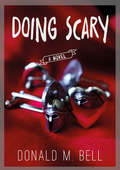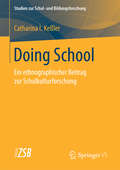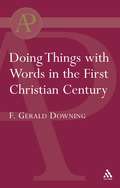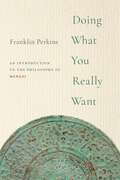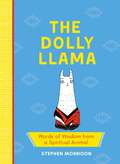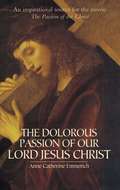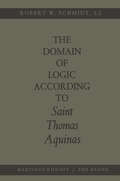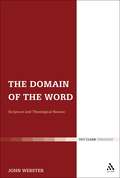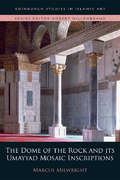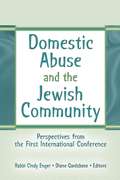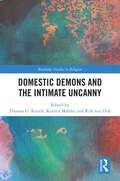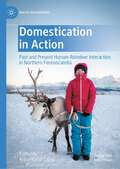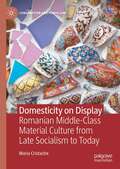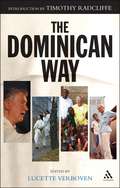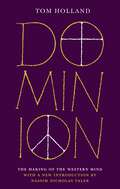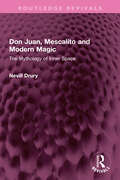- Table View
- List View
Doing Scary
by Donald M. BellTwo marriages haunted by betrayal. Four people whose pursuit of the American Dream has taken a nightmarish turn. Roman and Sage Bryant-Cole have spent nine months trying to salvage what was left of their marriage after it was rocked by the revelation of Roman’s serial affairs. Sage is dealt a second blow when she discovers that her cherished cousin, Owen Bryant, has been cheated on by his ruthless, gold-digging wife, Leah. Sage’s discovery hits the reset button on the progress she and Roman had been making on their marriage, as all the doubts and fears she has tried to suppress come flooding back. In order to reclaim Sage’s trust, and to save a love now left dangling by a thread, Roman must take his efforts to win back his wife to another level. Leah and Owen Bryant are visited by a ghost from their past; Leah’s college sweetheart, Casey. Leah and Owen must confront a dark secret at the heart of their marriage, if they are to stand a chance of surviving as a couple. One family’s legacy, two marriages, four lives, and millions of dollars are at stake. Doing Scary is a coming of age story which explores the transition from adolescence to adulthood and the battles we face in our thirties to keep our spiritual, emotional and psychological progress in check, as the things we hold most dear are put to the test.
Doing School: Ein ethnographischer Beitrag zur Schulkulturforschung (Studien zur Schul- und Bildungsforschung #63)
by Catharina I. KeßlerCatharina I. Keßler untersucht Schule als Feld der Praktiken und zeigt, wie die schulischen Akteure und Akteurinnen eines evangelischen Gymnasiums an der kontinuierlichen (Re-)Konstruktion ihrer Schule partizipieren. Die Ergebnisse einer achtmonatigen Feldforschung beziehen sich zum einen auf die inhaltliche Ausformung der konkreten Schulkultur mit Gemeinschaft und Kommunikation als wirkmächtige Werte sowie die Semantik des „Evangelischen“. Zum anderen bietet die Studie Anknüpfungspunkte für die qualitative Schulforschung insgesamt, indem sie zeigt, wie die kulturelle Teilhabe der schulischen Akteure und Akteurinnen konkret aussieht und welche Rolle dabei alltägliche Enkulturationsprozesse spielen.
Doing Theology with Photographs
by Sarah DunlopThis book is the first of its kind to fully explain how to use photographs for research within Practical Theology. An essential tool for anyone exploring how visual material can shed light on their research questions, the book functions as a guide to using the methods well. It includes a rationale for using photographs within the emerging field of empirical work within theology, which is useful for students or others within the academy who need to justify using a visual approach for their research projects and dissertations. Drawing on the author's own experience of using visual approaches, the book covers a variety of visual methods, including photojournalism, different types of photo elicitation, photo voice and studies of visual social media. Each chapter illustrates the method under discussion via a case study and photographs and contains a practical guide to using the method well and avoiding pitfalls. Additionally, the book explores how photographs can be used to resource theological reflection and spirituality, thus linking research and faithful practice within the rational for using visual material.Designed for the classroom use, each chapter contains:- Chapter summary (learning points)- Background information- 'how to' with examples of research projects- Advantages and limitations of the method- Conclusion
Doing Theology with Photographs
by Sarah DunlopThis book is the first of its kind to fully explain how to use photographs for research within Practical Theology. An essential tool for anyone exploring how visual material can shed light on their research questions, the book functions as a guide to using the methods well. It includes a rationale for using photographs within the emerging field of empirical work within theology, which is useful for students or others within the academy who need to justify using a visual approach for their research projects and dissertations. Drawing on the author's own experience of using visual approaches, the book covers a variety of visual methods, including photojournalism, different types of photo elicitation, photo voice and studies of visual social media. Each chapter illustrates the method under discussion via a case study and photographs and contains a practical guide to using the method well and avoiding pitfalls. Additionally, the book explores how photographs can be used to resource theological reflection and spirituality, thus linking research and faithful practice within the rational for using visual material.Designed for the classroom use, each chapter contains:- Chapter summary (learning points)- Background information- 'how to' with examples of research projects- Advantages and limitations of the method- Conclusion
Doing Things with Words in the First Christian Century (The Library of New Testament Studies #200)
by Francis Gerald DowningAlthough its religious heritage was that of a variegated Judaism, the tiny early Christian movement was nevertheless much more complexly and richly linked with the Graeco-Roman world in which it came to birth than is usually allowed for. In particular, 'ordinary' people were capable of a sophisticated use of words that can be detected also in the New Testament writings. But the use of words in Graeco-Roman times was often very different from what we suppose, and this collection of studies attempts to identify some of the anachronisms that still pervade even the best of modern scholarship.
Doing What You Really Want: An Introduction to the Philosophy of Mengzi
by Franklin PerkinsFor more than two thousand years, the writings of the Confucian philosopher Mengzi have been a source of guidance and inspiration for those set on doing something to improve the state of the world. In Doing What You Really Want, Franklin Perkins presents a coherent, systematic, and accessible explanation of Mengzi's philosophy. He covers everything from the place of human beings in nature, to human psychology and philosophy of emotions, to the various ways in which we can deliberately change and cultivate ourselves. Mengzi was concerned not just with theory but also effective action. Perkins thus includes a collection of practical advice and a Confucian analysis of politics oriented toward how individuals can make a difference in the world. These topics are integrated around Mengzi's philosophy as a way of life dedicated to changing the world, providing an alternative approach for understanding the contemporary relevance of Confucianism. Mengzi offers theoretical and practical resources valuable for anyone concerned with integrating efforts to improve the world with personal fulfillment and a sense of belonging. Rather than giving an overview, this is a focused work of philosophy that delves deeply into the most relevant themes of Mengzi's thought. The core philosophical system is drawn from Mengzi, but the book regularly incorporates other Confucian materials, making this volume a useful introduction to Confucian thought.
Doing What You Really Want: An Introduction to the Philosophy of Mengzi
by Franklin PerkinsFor more than two thousand years, the writings of the Confucian philosopher Mengzi have been a source of guidance and inspiration for those set on doing something to improve the state of the world. In Doing What You Really Want, Franklin Perkins presents a coherent, systematic, and accessible explanation of Mengzi's philosophy. He covers everything from the place of human beings in nature, to human psychology and philosophy of emotions, to the various ways in which we can deliberately change and cultivate ourselves. Mengzi was concerned not just with theory but also effective action. Perkins thus includes a collection of practical advice and a Confucian analysis of politics oriented toward how individuals can make a difference in the world. These topics are integrated around Mengzi's philosophy as a way of life dedicated to changing the world, providing an alternative approach for understanding the contemporary relevance of Confucianism. Mengzi offers theoretical and practical resources valuable for anyone concerned with integrating efforts to improve the world with personal fulfillment and a sense of belonging. Rather than giving an overview, this is a focused work of philosophy that delves deeply into the most relevant themes of Mengzi's thought. The core philosophical system is drawn from Mengzi, but the book regularly incorporates other Confucian materials, making this volume a useful introduction to Confucian thought.
The Dolly Llama: Words of Wisdom from a Spiritual Animal
by Stephen Morrison‘Ridiculous and funny’ – GREG DAVIES‘In a fast-moving world, the only self-help book I recommend is this collection of the words from the Dolly Llama’ – ED GAMBLELlama Karma lies within you.The Dolly Llama, the world’s first behooved spiritual leader, shares his words of wisdom and spiritual teachings for the first time. In this gem of a book he shows you how cultivate Llama Karma and to bring peace, compassion and ‘cuditation’ (a form of chewing and meditation) into your everyday life.His Gentleness has drawn great inspiration from ‘the four bales of wisdom’ which have helped many grazer browsers before him on the rocky path of life. Take a leaf out of this book and learn how Llama Karma can help you harness inner calm, as well as cope with everyday problems like hoof infection. The perfect gift for llama-lovers, spiritualists and animal-lovers alike.
The Dolorous Passion of Our Lord Jesus Christ (Mobi Classics Ser.)
by Anne Catherine EmmerichDuring the Lenten season of 1823, a German nun experienced a series of ecstatic visions that transported her to Jerusalem on the eve of the Last Supper. This is her compelling visionary account of the events surrounding Jesus' final days. A primary source for Mel Gibson's epic movie, The Passion of the Christ.
The Domain of Logic According to Saint Thomas Aquinas
by Robert W. SchmidtEver since philosophy became conscious of itself, there has been a problem of the relations between the real world which philosophy sought to understand and explain, and the thought by which it sought to explain it. It was found that thought had certain requirements and conditions of its own. If the real world was to be understood through thought, there was a question whether thought and the real correspond ed in all respects, and therefore whether they had the same conditions and laws, or whether some of these were peculiar to thought alone. For the solution of this problem it was necessary to study thought and the process of knowing and the conditions which the manner of know ing placed upon our interpretation of the real. With a consciousness of the peculiarities of thought and of its laws, philosophers could then more surely make use of it to arrive at the knowledge of the real world which they were seeking, without danger of reading into the real what is peculiar to thought. This necessity gave rise to the science of logic, a science which is still necessary, and for the same reasons. It has an importance in philosophy which it is disastrous to overlook.
The Domain of the Word: Scripture and Theological Reason
by John WebsterThe book brings together a set of related studies on the nature of Scripture and of Christian theology by one of the most prominent representatives of Protestant theology of our time. After a brief introduction on the setting of the book and its major themes, the first part of the volume examines topics on the nature and interpretation of Scripture. A comprehensive proposal about Scripture and its interpretation is followed by a study of Scripture as the embassy of the risen Christ, and by three related chapters analyzing the ways in which widely different major modern theologians (Barth, T.F. Torrance and Rowan Williams) have understood the nature and interpretation of the Bible. The second part of the volume makes a cumulative proposal about the nature and tasks of Christian theology, examining the fundamental principles of systematic theology, the distinctive role and scope of reason in Christian theology, the relation of theology to the humanities, and the vocation of theology to promote the peace of the church.
The Domain of the Word: Scripture and Theological Reason
by John WebsterThe book brings together a set of related studies on the nature of Scripture and of Christian theology by one of the most prominent representatives of Protestant theology of our time. After a brief introduction on the setting of the book and its major themes, the first part of the volume examines topics on the nature and interpretation of Scripture. A comprehensive proposal about Scripture and its interpretation is followed by a study of Scripture as the embassy of the risen Christ, and by three related chapters analyzing the ways in which widely different major modern theologians (Barth, T.F. Torrance and Rowan Williams) have understood the nature and interpretation of the Bible. The second part of the volume makes a cumulative proposal about the nature and tasks of Christian theology, examining the fundamental principles of systematic theology, the distinctive role and scope of reason in Christian theology, the relation of theology to the humanities, and the vocation of theology to promote the peace of the church.
The Dome of the Rock and its Umayyad Mosaic Inscriptions (Edinburgh Studies in Islamic Art)
by Marcus MilwrightLocated on the Temple Mount in Jerusalem, the Dome of the Rock was constructed at the end of the seventh century by order of caliph ‘Abd al-Malik. This seminal structure has been much studied but no definitive interpretation yet exists of the meanings conveyed by the Dome at the time of its completion. The recovery of meaning is complicated by the paucity of primary written sources relating to the construction phases of the building and the motivations of its patron. This book concentrates on the most important surviving primary text, the long mosaic inscription running around the interior. Comprising a dedication and date (72/691-92) and material of a religious nature, the mosaic inscription provides vital evidence for the reconstruction of the meanings and functions of the Dome of the Rock. The detailed study of the mosaics helps to place them in the context of Late Antique monumental writing, particularly in Greek. The book makes use of contemporary Islamic coins, graffiti, and other inscribed objects in order to examine the Dome of the Rock in the relation to the ideological concerns of the Umayyad elite during and after the second Civil War.
Domestic Abuse and the Jewish Community: Perspectives from the First International Conference
by Diane GardsbaneLearn ways to address domestic and sexual abuse in your communityBreaking the cycle of domestic violence and abuse poses unique problems for the Jewish community, owing to the internal divisions of politics, religious practice, and culture. However, creating strategies to work together based upon the shared values of Judaism can strip away those differences. Domestic Abuse and the Jewish Community: Perspectives from the First International Conference brings together an outstanding and diverse selection of notable presentations from the First International Conference on Domestic Abuse in the Jewish Community held in July 2003 in Baltimore, Maryland. The conference, entitled "Pursuing Truth, Justice, and Righteousness: A Call to Action," brought to the forefront the disturbing, many times hidden issue of domestic abuse within the Jewish community. Respected scholars, clergy, social service professionals, and survivors provide insightful presentations that lay an essential foundation for the building of a collaborative global Jewish movement to respond to this sensitive issue.Domestic Abuse and the Jewish Community: Perspectives from the First International Conference marks the start of a quiet revolution aimed at ending domestic abuse in various Jewish communities by revealing the many facets of the problem while offering ways to address them. Sexual and domestic abuse issues in the Jewish communities of the US, Israel, South Africa and the UK are illuminated and described, and practical strategies are discussed, keeping in mind the common goals within the varied communities. Jewish religious law is reviewed, along with an analysis of Maimomides&’ response to domestic abuse, and a vision is offered to respond to child sexual abuse.Domestic Abuse and the Jewish Community: Perspectives from the First International Conference is separated into five categories of presentations: Illuminating the Issue; Healing and Wholeness; Promising Practices; Creating Change; and Breaking the Cycle, each section progressing logically to present a unified discussion of the issues. The book discusses: helping religious women escape domestic abuse the Jewish tradition and the treatment of battered women the widespread claim that Maimonedes condoned wife-battering the spiritual movement called neohasidism the issues of reconciliation between survivors and former perpetrators the Ayelet Program-a project which provides long-term mentoring to past victims starting a new life organizing the community to address domestic violence in immigrant populations the response to domestic violence in the South African Jewish community services for victims in Israel child sexual abuse and incest Domestic Abuse and the Jewish Community: Perspectives from the First International Conference is informative, eye-opening reading for social workers, clergy, direct service providers for survivors of domestic/sexual abuse, directors/staff of Jewish Family Service agencies, Jewish Federations, Jewish women&’s organizations, and Jewish foundations.
Domestic Abuse and the Jewish Community: Perspectives from the First International Conference
by Diane GardsbaneLearn ways to address domestic and sexual abuse in your communityBreaking the cycle of domestic violence and abuse poses unique problems for the Jewish community, owing to the internal divisions of politics, religious practice, and culture. However, creating strategies to work together based upon the shared values of Judaism can strip away those differences. Domestic Abuse and the Jewish Community: Perspectives from the First International Conference brings together an outstanding and diverse selection of notable presentations from the First International Conference on Domestic Abuse in the Jewish Community held in July 2003 in Baltimore, Maryland. The conference, entitled "Pursuing Truth, Justice, and Righteousness: A Call to Action," brought to the forefront the disturbing, many times hidden issue of domestic abuse within the Jewish community. Respected scholars, clergy, social service professionals, and survivors provide insightful presentations that lay an essential foundation for the building of a collaborative global Jewish movement to respond to this sensitive issue.Domestic Abuse and the Jewish Community: Perspectives from the First International Conference marks the start of a quiet revolution aimed at ending domestic abuse in various Jewish communities by revealing the many facets of the problem while offering ways to address them. Sexual and domestic abuse issues in the Jewish communities of the US, Israel, South Africa and the UK are illuminated and described, and practical strategies are discussed, keeping in mind the common goals within the varied communities. Jewish religious law is reviewed, along with an analysis of Maimomides&’ response to domestic abuse, and a vision is offered to respond to child sexual abuse.Domestic Abuse and the Jewish Community: Perspectives from the First International Conference is separated into five categories of presentations: Illuminating the Issue; Healing and Wholeness; Promising Practices; Creating Change; and Breaking the Cycle, each section progressing logically to present a unified discussion of the issues. The book discusses: helping religious women escape domestic abuse the Jewish tradition and the treatment of battered women the widespread claim that Maimonedes condoned wife-battering the spiritual movement called neohasidism the issues of reconciliation between survivors and former perpetrators the Ayelet Program-a project which provides long-term mentoring to past victims starting a new life organizing the community to address domestic violence in immigrant populations the response to domestic violence in the South African Jewish community services for victims in Israel child sexual abuse and incest Domestic Abuse and the Jewish Community: Perspectives from the First International Conference is informative, eye-opening reading for social workers, clergy, direct service providers for survivors of domestic/sexual abuse, directors/staff of Jewish Family Service agencies, Jewish Federations, Jewish women&’s organizations, and Jewish foundations.
Domestic Demons and the Intimate Uncanny (Routledge Studies in Religion)
by Thomas G. Kirsch Kirsten Mahlke Rijk Van DijkThis book explores local cultural discourses and practices relating to manifestations and experiences of the demonic, the spectral and the uncanny, probing into their effects on people’s domestic and intimate spheres of life. The chapters examine the uncanny in a cross-cultural manner, involving empirically rich case studies from sub-Saharan Africa, Latin America and Europe. They use an interdisciplinary and comparative approach to show how people are affected by their intimate interactions with spiritual beings. While several chapters focus on the tensions between public and private spheres that emerge in the context of spiritual encounters, others explore what kind of relationships between humans and demonic entities are imagined to exist and in what ways these imaginations can be interpreted as a commentary on people’s concerns and social realities. Offering a critical look at a form of spiritual experience that often lacks academic examination, this book will be of great use to scholars of Religious Studies who are interested in the occult and paranormal, as well as academics working in Anthropology, Sociology, African Studies, Latin American Studies, Gender Studies and Transcultural Psychology.
Domestic Demons and the Intimate Uncanny (Routledge Studies in Religion)
by Thomas G. Kirsch Kirsten Mahlke Rijk Van DijkThis book explores local cultural discourses and practices relating to manifestations and experiences of the demonic, the spectral and the uncanny, probing into their effects on people’s domestic and intimate spheres of life. The chapters examine the uncanny in a cross-cultural manner, involving empirically rich case studies from sub-Saharan Africa, Latin America and Europe. They use an interdisciplinary and comparative approach to show how people are affected by their intimate interactions with spiritual beings. While several chapters focus on the tensions between public and private spheres that emerge in the context of spiritual encounters, others explore what kind of relationships between humans and demonic entities are imagined to exist and in what ways these imaginations can be interpreted as a commentary on people’s concerns and social realities. Offering a critical look at a form of spiritual experience that often lacks academic examination, this book will be of great use to scholars of Religious Studies who are interested in the occult and paranormal, as well as academics working in Anthropology, Sociology, African Studies, Latin American Studies, Gender Studies and Transcultural Psychology.
Domestication in Action: Past and Present Human-Reindeer Interaction in Northern Fennoscandia (Arctic Encounters)
by Anna-Kaisa SalmiReindeer have been an integral part of the lives of people in Northern Fennoscandia in prehistoric and historic times. Today, reindeer herding practices are changing fast due to climate change, land use pressures and new technologies. This book outlines recent advances in the archaeology of reindeer domestication and development of reindeer herding among the Sámi of Northern Fennoscandia, focusing especially on the identification and understanding of various reindeer herding tasks and practices through archaeological evidence and traditional knowledge of reindeer herders. Covering more than a thousand years of history of reindeer herding, the book explores how reindeer herding practices have always been dynamic and adapted to the changing social, economic and environmental pressures. While reindeer herding practices have changed, they have also retained memory and tradition. The continuity and adaptation of reindeer herding testifies of the resilience of reindeer herders and their animals, and the importance of their relationship in the changing Arctic. This book will be of interest to scholars interested in archaeology, anthropology, and history of the Arctic, as well as local communities and reindeer herders.
Domesticity on Display: Romanian Middle-Class Material Culture from Late Socialism to Today (Consumption and Public Life)
by Maria CristacheThis book examines postsocialist transformations reflected in urban middle-class domestic spaces and in museums dedicated to socialism in Romania. It focuses on the significance and circulation of porcelain and crystal sets and ornaments during late socialism and after 1989, following the experiences of consumers, workers in the glassware and porcelain industry, and artists. By tracing the values and temporalities embedded in materiality, the book sheds light on how objects shape daily life in a time of cultural, economic, and social change. Drawing on ethnographic research, the book offers an in-depth analysis of the ambiguous relation between the middle-class and the socialist state, using materiality and consumption to shed light on contradictions between aspirations and resources and between official discourses and everyday practices. The book reveals changes in practices of display, gift exchange, and barter, in the perception and use of time, as well as in gender and inter-generational relations.This work will be of interest to sociologists, anthropologists and cultural historians, especially researchers interested in consumption, material culture, postsocialism, the anthropology of value and gift, the study of social time, practices of the middle-class, and the history of consumption in Eastern Europe.
The Dominican Way
by Lucette VerbovenThe Dominicans are to be found in every part of the world and engaged in every sort of activity, from fighting for justice and peace to painting and poetry. They live on many frontiers, of the Church and of the World, of the rich and of the poor, of the West and East, and these are places of growth and discovery. This book will communicate some of the inspiration and excitement to be found there by women and men who are both utterly committed to their faith but also to what is to be learned as well.
The Dominican Way
by Lucette VerbovenThe Dominicans are to be found in every part of the world and engaged in every sort of activity, from fighting for justice and peace to painting and poetry. They live on many frontiers, of the Church and of the World, of the rich and of the poor, of the West and East, and these are places of growth and discovery. This book will communicate some of the inspiration and excitement to be found there by women and men who are both utterly committed to their faith but also to what is to be learned as well.
Dominion: The Making of the Western Mind
by Tom HollandChristianity is the most enduring and influential legacy of the ancient world, and its emergence the single most transformative development in Western history. Even the increasing number in the West today who have abandoned the faith of their forebears, and dismiss all religion as pointless superstition, remain recognisably its heirs. Seen close-up, the division between a sceptic and a believer may seem unbridgeable. Widen the focus, though, and Christianity's enduring impact upon the West can be seen in the emergence of much that has traditionally been cast as its nemesis: in science, in secularism, and yes, even in atheism. That is why Dominion will place the story of how we came to be what we are, and how we think the way that we do, in the broadest historical context. Ranging in time from the Persian invasion of Greece in 480 BC to the on-going migration crisis in Europe today, and from Nebuchadnezzar to the Beatles, it will explore just what it was that made Christianity so revolutionary and disruptive; how completely it came to saturate the mind-set of Latin Christendom; and why, in a West that has become increasingly doubtful of religion's claims, so many of its instincts remain irredeemably Christian. The aim is twofold: to make the reader appreciate just how novel and uncanny were Christian teachings when they first appeared in the world; and to make ourselves, and all that we take for granted, appear similarly strange in consequence. We stand at the end-point of an extraordinary transformation in the understanding of what it is to be human: one that can only be fully appreciated by tracing the arc of its parabola over millennia.
Don Juan, Mescalito and Modern Magic: The Mythology of Inner Space (Routledge Revivals)
by Nevill DruryFirst published in 1978, Don Juan, Mescalito and Modern Magic begins with an analysis of the Castaneda material from the viewpoint of its inherently magical content. The author examines the symbiotic gestures, the magical actions and the mind-altering techniques employed by the brujo Don Juan, and then goes on to draw comparisons with two other schools of thought: the psychedelic development of the 1960s and the Western Magical Tradition. The essential aim throughout is to show that there is a basically Western shamanism which uses Western symbols and is easily accessible. The shamanistic practices of the Hermetic Order of the Golden Dawn are examined in this context. Considerable emphasis is also placed on mythological aspects associated with out-of-the-body experiences and their relevance to both the Don Juan Mescalito imagery and the Qabalistic and Tarot symbols found in Western Magic. This book will be of interest to students of religion, history and literature.
Don Juan, Mescalito and Modern Magic: The Mythology of Inner Space (Routledge Revivals)
by Nevill DruryFirst published in 1978, Don Juan, Mescalito and Modern Magic begins with an analysis of the Castaneda material from the viewpoint of its inherently magical content. The author examines the symbiotic gestures, the magical actions and the mind-altering techniques employed by the brujo Don Juan, and then goes on to draw comparisons with two other schools of thought: the psychedelic development of the 1960s and the Western Magical Tradition. The essential aim throughout is to show that there is a basically Western shamanism which uses Western symbols and is easily accessible. The shamanistic practices of the Hermetic Order of the Golden Dawn are examined in this context. Considerable emphasis is also placed on mythological aspects associated with out-of-the-body experiences and their relevance to both the Don Juan Mescalito imagery and the Qabalistic and Tarot symbols found in Western Magic. This book will be of interest to students of religion, history and literature.
Don Quixote’s Impossible Quest for the Absolute in Literature: Fiction, Reflection, and Negative Theology (Routledge Studies in Latin American and Iberian Literature)
by William FrankeThis book offers a reading particularly of Part II of Don Quixote, a reading that is embedded in a philosophical reflection on the revelation of religious truth in and through literature. Part II of Don Quixote is the far richer part for its meta-literary reflection on the novel itself as a genre and on life as such seen through the lens of self-reflection. The author has treated the phenomenon of modern self-reflexivity as originally theological in nature in previous publications (notably Dante’s Paradiso and the Theological Origins of Modern Thought: Toward a Speculative Philosophy of Self-Reflection, Routledge, 2021). The present endeavor expands this overall intellectual project, extending it into detailed consideration of what is recognizably another nodal great work inaugurating unprecedented forms of self-reflection in the early modern period. Reading the founding texts of literary and cultural tradition in this negative-theological key proves crucial to allowing them to release the full force of their religious vision in the present age, despite its sometimes obstinate secularity. This reading absorbs and reconciles the religious and secular readings of Miguel de Unamuno and José Ortega y Gasset, two of Spain’s outstanding philosophical luminaries. Both thinkers based their entire philosophies and their analyses of the Spanish national character and destiny on their interpretations of the Quixote. Negative theology deploys critical reason that critiques the limits of reason itself and opens toward an unfathomable (un)ground of All. Such speculative interpretation performs a synthesis of the secularizing and sacralizing tendencies that are both sublimely operative in the text of the Quixote. It thereby enables the work to emerge in the fully parodic and paradoxical vitality that other interpretations, governed by one paradigm or the other, access only partially. Rather than falling into one camp or the other, the proposed approach combines and resources both heritages, sacred and secular, in their deepest synergisms. Spanish baroque mysticism and contemporary post-secular thought are made to converge in highlighting the blessed, even sacred, donation that literature like Don Quixote preserves and transmits as our most precious and saving cultural heritage.
